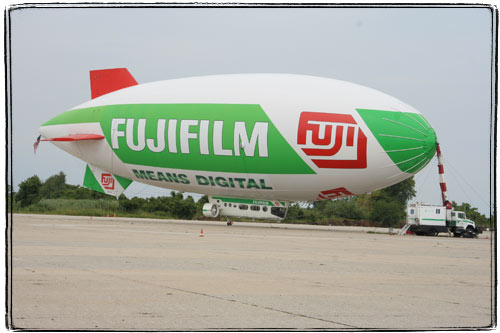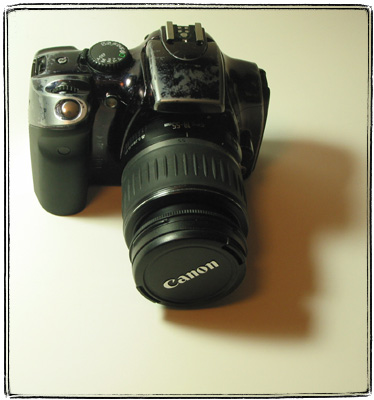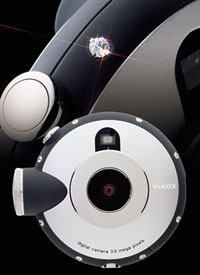Canon vs. Nikon
I often get asked for advice on what digital camera to buy. I’d estimate that I was asked that at least a dozen times in the last couple of years. I’ve been asked by co-workers, friends, family.
I usually explain things this way: there are two classes of cameras — SLR and what used to be called “rangefinder“. SLRs range from bulky and heavy to galaxy sized black hole; from very expensive to small-Manhattan-studio-apartment-down-payment expensive. Rangefinders range from 007-spy-camera-sized to brick-sized; from very cheap to pretty damn expensive. The image quality on both types ranges from crappy to very good.
SLRs have one huge advantage: they look professional. And expensive. Two advantages. Well, actually while we are at it, there is a third advantage, and the only one that matters. Some SLRs come as a part of a camera system. A camera system is a collection of accessories that your camera can take. It includes lenses, flashes, extension rings, adapters, and other various obscure doodads like focusing screens and right angle viewfinders. Repeat with me – it’s not the camera body and the lens it comes with. It’s the System that matters.
When you are buying a non-system camera, you have to make a one piece investment as you won’t be able to upgrade it later. With system SLRs, your investment in lenses, flashes and other accessories is separate and much longer lasting than investment in the body of the camera. More than that, you’ll have a choice of several camera bodies at different price points. But the main thing is, you can have a lens and accessory collection and it will stay with you for many years.
In the olden days there were popular rangefinder systems and even TLR systems. Not anymore. But the main reason for rangefinder popularity still remains: they are smaller and easier to use than SLRs. A picture taken with a well-made rangefinder will be almost indistinguishable from that taken with a well-made SLR with a normal range lens (that is, not a macro or telephoto or something even more exotic). Rangefinders add something to photography that no SLR can add – spontaneity. To be able to whip a camera out of your shirt pocket and take a picture is priceless. 70% of photographic opportunities disappear in the time that it takes to take an SLR out of the bag.
I often try to steer people into buying a nice rangefinder because I know that they’ll take it with them more, take more pictures and enjoy it more. A camera that wants to stay at home is not of much use, unless, of course, like me, you are Ok with dragging a heavy bag with you everywhere.
If it’s the SLR that they want, I explain the choice even simpler. You have to buy into a major camera system, which these days means Canon or Nikon. Once you buy your camera and lenses, you are pretty much stuck with the system, unless you never buy any expensive lenses.
Canon and Nikon systems are pretty equivalent in quality and variety. They are both awesome. Generally Nikon stuff is heavier and sturdier, and also more expensive. Just about anybody finds that appealing. I find the relative heaviness a huge drawback. Picture quality at slow shutter speed is mainly limited by three factors: sensor quality, lens quality and camera shake. So, if you are not using a tripod for every shot, a heavy, although sturdy camera is a huge drawback – it will make your hands shake a lot more than a lighter one. For these two reasons I am, and always was a fan of Canon.
Most of the people I ever advised on purchasing a camera bought Nikons though. More than that, most of my friends and co-workers are Nikon owners already. As a rule of thumb, prosumers that I know like Nikons. In general, among professionals and amateurs, Canon and Nikon are represented equally, as far as I can tell.
I do have one observation that might raise a lot of controversy. I find, in my empirical observations, that Canon owners take and share way more pictures than Nikon owners. Nikons are usually found stashed away at home, while Canons are out there in the world, taking pictures. Since 2000, I took about 25K photos, and a I guess I am a typical Canon user. So is Travis Ruse, one of my favorite photobloggers. So is Tema Lebedev, my favorite travel blogger. What about you, Nikonophiles? Where are your pictures?
Philip Greenspun has a nice technical Canon vs Nikon comparison, as well as a good description of the Canon system, and one of Nikon.
I’ve added a camera-related poll.
A Space Potato Made of Poison
Jeffrey Rowland drew me a custom watercolor of my favorite comic character on the internets for a pen tablet that I was not using. Chump.
“A born warrior, Topato possesses a large, loud vocabulary and fears nothing. He is made of a poison that triggers agonizing death in his opponents. Topato is a licensed attorney.”

Deadprogrammer recommends:
The Best Software Writing I: Selected and Introduced by Joel Spolsky
Blimp Blamp
Fujifilm blimp moored over at Floyd Bennett Field.

A few notes:
* As it turns out the word “blimp” comes from the sound that occurs when one flicks the skin of a balloon.
* Poor Fujifilm branders. To most people “Fujifilm” means “film”, not “digital.” It’s kind of like branding with the slogan “Luftschiffbau Zeppelin GmbH means safe transatlantic flights.” That’s not what people remember, is it?
* Actually, Fujifilm makes absolutely awesome laser exposure printers for digital photos. They basically use lasers to expose regular photo paper, resulting in a digital print that has all the characteristics of a regular print. Unfortunately most digital photo printing services don’t let you know what kind of printing equipment they use or at what resolution they print.
Ad:
The Fantom Photo Album
Being a fan of photography has its upsides and downsides. On one hand photographers notice more things. Beautiful things. Unusual things. Things that only can be seen through the lens of the camera that lives inside your brain.
On the other, if they don’t have a camera handy, or the batteries are dead, or there’s too little light, or if taking photos is prohibited or just simply not wise – photographers become agitated and miserable. Oh, the most wonderful moments that should be simply enjoyed can be poisoned by worrying about lighting, f-stops above all — the lack of camera in your hands.
The shots that did not happen – those are the worst. They linger in your head for a while, but then the moment passes, and the fata morgana of the perfectly composed and exposed picture dissolves into the bitterness of a missed shot. It’s even worse if you just did not have the guts to take out your fully charged, properly equipped camera and point it’s soul stealing eye at the situations, people, things and places that simply must be photographed.
Let’s see, off the top of my head, three shots that did not happen and still drive me nuts:
1) A young woman occupying the two-person seat of the R40 train (you know, the one next to the cab), bathed in the unearthly greenish glare of fluorescent lights, opposite a guy reading a newspaper and another one dozing. She is as pissed off as can be, the expression on her face a mask of anger, sadness and disgust. Yet she is dressed in a brilliantly colored butterfly costume, with big transparent wings. I just did not have the heart to take out my camera from my bag.
2) A bum sitting in the street, slumped in a cheap computer chair, kind of like the guy on the logo of my website. He rested his head on the handle of a shopping cart filled with ivory colored computer towers and topped with an old CRT monitor, a keyboard and even a couple of mice and modems. I think I even noticed a hub in there somewhere. The yellow plastic of old equipment and the depressed, bearded and unwashed guy would have looked ordinary in a cubicle farm, but outside in the midday New York sun they looked sad and alien. My camera was with me, but I forgot the flash card at work.
3) Japanese museum, a glassed in stand containing a samurai’s suit of armor, surprisingly small in size. The ghostly reflection of a petit Japanese girl’s face just would not line up with the dark opening in front of the horned helmet. The museum was closing, the lighting was dim, and I just did not feel like waiting for the perfect shot.
But then again, there are times when you take a picture, and then feel that you probably should not have. Those primitive people that feel that a photograph steals one’s soul might be onto something. It sure feels that way sometimes.Being a fan of photography has its upsides and downsides. On one hand photographers notice more things. Beautiful things. Unusual things. Things that only can be seen through the lens of the camera that lives inside your brain.
Digital Rebel, Limited Deadprogrammer Edition
Even though I am squarely in the EOS camp, I have to note that Nikon usually does not force the indignity of owning a silvery plastic camera on the buyers of lower end models of their slrs. Dear Canon, please fricking stop using that silvery plastic!
A few weeks ago I got so annoyed looking at my Digital Rebel that I took a permanent black marker and made my own “Limited Edition” :

This might not have been the best idea as the resale value of my $800 camera suddenly took a nosedive, but the “paintjob” turned out to be remarkably durable (it only came off around the shutter button and the top a little), but also gave my camera a mean, grungy look that I like a lot.
I think I will buy some Krylon Fusion paint and do a less half-assed jobs. There are people out there who used similar paint to modify old silvery rangefinders.
In other news, reading through boring link blogs and popular link aggregators slowly pays off:
This is hard to believe, but there are Nikon lens to Canon camera adapters. I think I’ll buy one – I do not own any Nikon lenses, but have a lot of friends that own some pretty expensive ones. By the way, this might start a small flame avalanche, but in my experience most of the people that I know who own Nikon SLRs brag about having many very expensive lenses, but for some reason do not take a lot of pictures. Canon owners tend to have few cheapo lenses, but have pictures coming out their wazoo. (by the way, dictionary.com’s explanation of etymology of wazoo is not very convincing).
UV Filters considered harmful. I was never a fan of putting a glorified piece of window glass in front of my lens, but could not figure out why. Now I know. (I think I snagged this link from Kottke).
Making a lens out of an old magnifying glass and free time. This is some fine ducttapemanship.
Does Your Digital Camera Have Enough Bling?
I was researching subminiature digital cameras when I stumbled on a webpage of a company that makes an affordable diamond studded digital camera.
That’s right. MINOX DD1 Diamond has 8 synthetic diamonds.

Mechanical watch manufacturers used to proudly advertise how many synthetic “jewels” were used in the watch mechanism. Then radio manufacturers used to brag about the number of transistors (sometimes even adding unnecessary transistors to the circuit). Now it is all about megahertz, megabytes and megapixels. Don’t you think it’s time to go back to jewels?
And Lipstick Too
I have a small collection of cheap box cameras that my grandfather bough for my in his garage sale adventures. I decided to look into filling the rest of space in one of my bookshelves with specimens from eBay. One thing that I often do is sort the auctions descending by price. That way I often find most curious stuff. On the top of the search for “Kodak Brownie” were two amazingly beautiful cameras with striking art deco design:
And this wasn’t a fluke either. Kodak also made “Coquette”, which featured a lightning bolt art deco design and came with a matching lipstick holder.
Take a plain box, give it a new design and add some color. Everything old is new again, right?
I think Apple should try to add a matching lipstick holder.
Good Stuff
I recently purchased “Looking at Photographs : 100 Pictures from the Collection of The Museum of Modern Art“. This is another outstanding book recommended to me by the inhuman intelligence of Amazon’s engine.
I can only imagine the torturous process that the author of this book must have gone through. I mean, how do you select 100 important photographs from Museum of Modern Art’s collection? And then write an article about the author, the photograph, the historical context and significance, the camera and photographic process used – all on one page? That must have been pure agony.
This book made me think a lot about photography and photographers. I need to write more about that.
In other news I only recently noticed how good
Auto Moto Velo Photo
My two favorite photography books about New York are David Bradford’s Drive by Shootings : Photographs by a New York Taxi Driver and Harvey Wang’s New York.
You might have noticed a decorative border that I almost always put around my photographs. I first seen it in Harvey Wang’s book. I asked my photography professor in college about how that effect was achieved. She explained to me that Wang took his negative holder and filed down the edges. This projected not only the picture from the negative, but also a little bit of the edge and film sprockets onto the paper. Besides looking cool and framing the picture nicely this also was a way of showing off – this shows that none of his photographs were cropped. It’s like he was saying – look, my framing is perfect, cropping is for wussies. I am a wussie. I crop like there is no tomorrow. And since I am only using digital these days, I rely on a Photoshop plugin called Extensis Photoframe.


